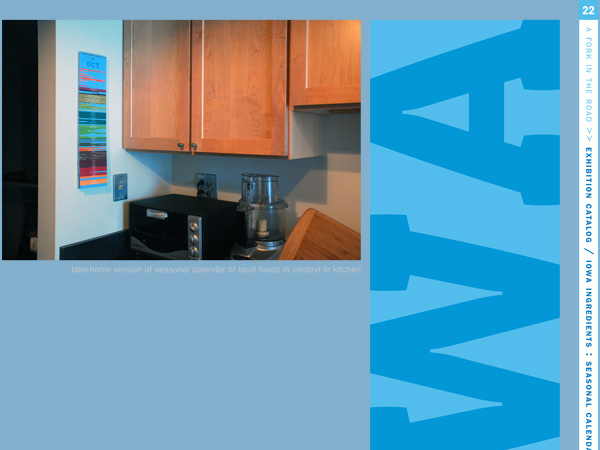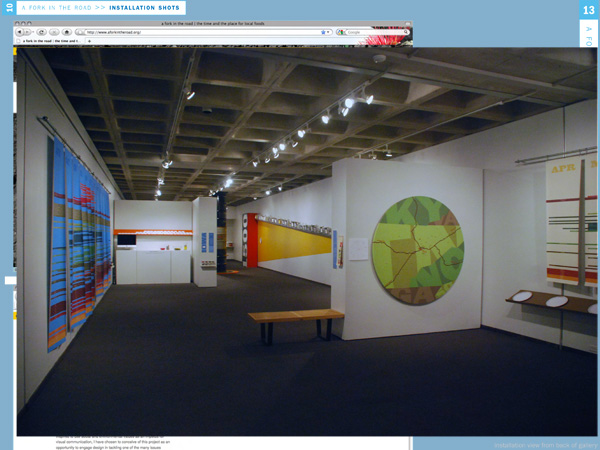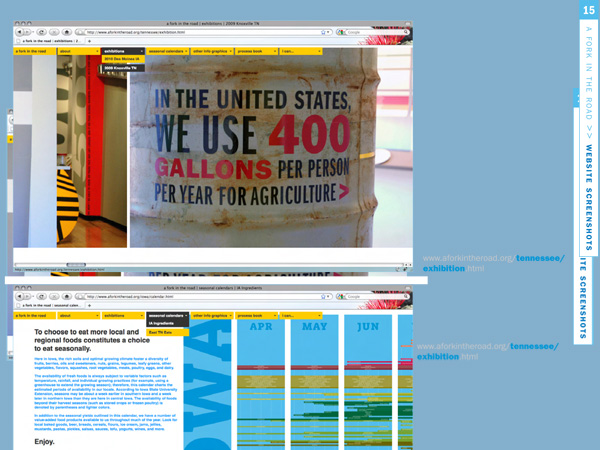-
Categories
- All Winners
- Branding
- Environmental Graphics
- Interactive
- Miscellaneous
- Motion Graphics
- Packaging
- Publications
A Fork in the Road



By Hilary Dana Williams
The Idea
This is a self-generated project in which I have operated as designer-as-author, so there is no client.
——–
Inspired to use social and environmental values as an impetus for visual communication, I have chosen to conceive of this project as an opportunity to engage design in tackling one of the many issues challenging our times: the scale and consequences of our industrial food system. Being moved by statistics about the relationship between food and fossil fuels in my preliminary research on global warming, I began to focus on the task of visualizing the invisible in our everyday eating habits.
I have considered my design process in the context of this question: In what ways can the design of an exhibition provide both incentives and implements to prompt people to change individual habits for the common good?
This is a general question that I envision can be applied to any set of habits that affect the common good. In the case of this exhibition, I have aimed specifically to increase the consumption of local and regional foodsラfirst in East Tennessee, now in Iowa.
I assert that it is critical not only to raise awareness about issues such as the scale and consequences of our industrial food system, but also simultaneously to facilitate a response to this newfound understanding. Therefore, I am presenting both information graphics (the モwhyヤ) and prototypes (the モhowヤ) that could enable incremental changes in food purchasing and eating habits. My solutions toward this twofold end have ranged from the nauseating visualization of 1.1 million dots on a wall to the design of a calendar charting the seasonality of foods growing in each locale. The latter demonstrates my commitment to making this exhibition specific to the audiences in both Knoxville and Des Moines.
Through my ongoing research process, I have come to appreciate the universality of food as a topic, and I continue to respect the complexity of food ethics and food production. What I recognize about モlocalヤ as a criterion for food is the breadth of its effect: to buy and to eat more local and regional foods is not merely an environmentalist agendaラit is an act that impacts ecological health and economic health and human health and community health. What aims could be more universal?
My project seems to have become more timely as it has evolved. First the unprecedented global economic crisis and now the massive oil spill have revealed that the large-scale systems that we often take for granted are not necessarily stable or sustainable, and so it is increasingly apparent that we need to develop alternative systems. Our food systemラthat on which our very lives dependラis an appropriate one to tend to first.
Delivery of Work
A gallery exhibition is perhaps an unusual venue through which to prompt people to change food habits, but I found it to be a promising one. A gallery can provide a temporary collective space in which people can encounter new ideas in the company of others. At the exhibition at the Anderson Gallery in Fall 2010, I was heartened to see a wider range of the general public than one might be accustomed to seeing at university galleries; the 150 or so folks who came to the opening appeared to be diverse in age, university affiliation, familiarity with art and design, and environmental awareness.
There were lively conversations throughout the night, and so I feel honored to have inspired engaged dialogue about what I consider to be one of the most pressing issues of our time. The integration of 2D, 3D, and digital components in the installation provided multiple entry points to the information in visually engaging ways, and I suspect that this made the content approachable.
Given that an exhibition is usually complemented by an exhibition catalog, I decided to co-opt this publication as a means by which to get the seasonal calendar of local foods in Iowa out to the public for free. Rather than including photographs of the installation in the catalog, I referenced the exhibition website for documentation and then devoted the bulk of the publication to the seasonal calendar. This take-home version of the larger calendar banners on display in the gallery can serve as a resource year after year.
The Results
Judging by survey responses, commitments on "i can..." cards, and anecdotal comments, the exhibition was moving. The survey results from the first exhibition in Knoxville, Tennessee, indicated a 70% overall 'Wow! This moves me enough to consider changing my habits' response. Furthermore, the survey results pointed to the seasonal calendar of local foods being the most moving component in terms of raising awareness and changing habits. This feedback led to my aforementioned decision to make an initial run of the re-localized take-home calendar free and accessible to the public at the second exhibition in Des Moines, Iowa. Nearly all 300 copies were taken by visitors over the duration of the exhibition. I hear that the calendars are hanging in many a home kitchen and even being used as planning/planting resources for the school garden at a local alternative high school. I have been heartened to hear anecdotally that the exhibition has elicited an empowering response, despite the inclusion of so many staggering statistics. I trust that the pairing of implements with information has fueled this effect.
Credits
-
Graphic Designers
- Hilary Dana Williams
-
Printers
- Artcraft Inc
- Garner Printing
- UCopy
Event Sponsors







Additional generous support provided by Lagunitas Brewing Comapny and The Fraternal Order of Eagles #34
